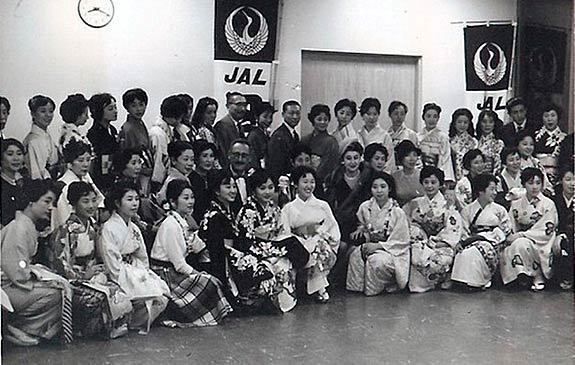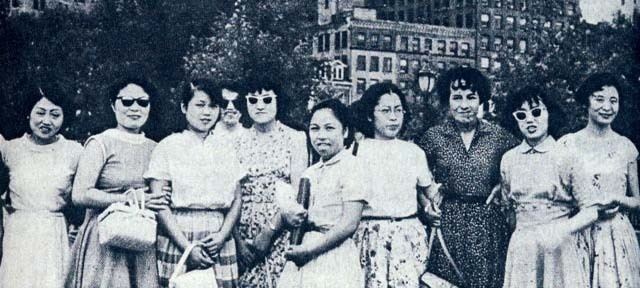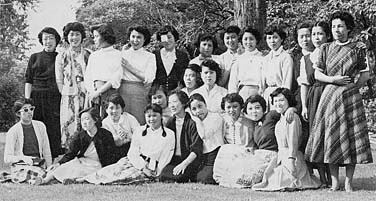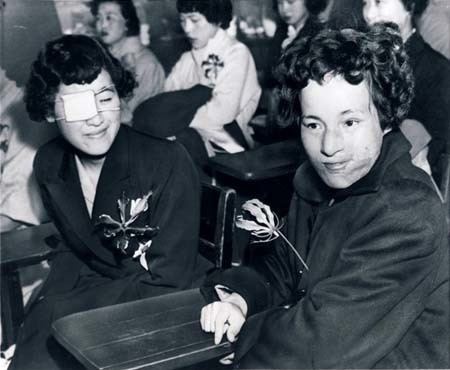 | ||
Hd stock footage hiroshima maidens depart for japan
The Hiroshima Maidens are a group of 25 Japanese women who were school age girls when they were seriously disfigured as a result of the thermal flash of the fission bomb dropped on Hiroshima on the morning of August 6, 1945. They subsequently went on a highly publicized journey to get reconstructive surgery in the US in 1955.
Contents
- Hd stock footage hiroshima maidens depart for japan
- Creation
- Media in the West
- Atomic Bomb Maidens
- Life after reconstruction
- List
- In popular culture
- References

Keloid scars from their burns marred their faces and many of their hand burns healed into bent claw-like positions. These women, as well as the other citizens affected by the A-bomb, were referred to as hibakusha, meaning "explosion-affected people".

Creation

By 1951, Hiroshima bomb survivor Shigeko Niimoto had endured several unsuccessful Japanese operations to repair scarring on her face. Following a Christian church meeting with Reverend Kiyoshi Tanimoto, he invited her to a meeting of bomb-affected people. Upon arriving and finding the meetings discussion too political for her tastes, Niimoto suggested to Rev. Tanimoto that they form a support group for the dozen or so young women who he knew with similar injuries and concerns. Soon they were meeting regularly in the basement of his church. The women had all experienced similar lives following the war, such as being hidden from view by parents, stared at when they ventured outside, unwanted by employers, and rejected as potential wives for fear they were genetically damaged. As Tanimoto had gained some fame in America as a subject of a celebrated 1946 magazine/book article by journalist John Hersey titled Hiroshima, Tanimoto joined American journalists to create a charitable foundation to help victims of Hiroshima and "explore the ways of peace."

Hersey, Pearl S. Buck, Norman Cousins and Reverend Marvin Green were Tanimoto's partners in the Hiroshima Peace Centre Foundation.

The group of scarred women was one of the foundation's projects, with Tanimoto calling it the Society of Keloid Girls. Following the help from newspaper columnist, Shizue Masugi, Tanimoto began raising funds to get plastic surgery for his group. Newspapers dubbed them genbaku otome, or "atomic bomb maidens," and in 1952 about 20 of them were treated in Tokyo and Osaka. Plastic surgery in Japan was not as advanced as it was in the United States so Tanimoto tried to find a way to get the "maidens" to America. Once aware of his efforts Saturday Review editor Norman Cousins pledged to help Tanimoto. They found two doctors, William Maxwell Hitzig and Arthur Barsky of Mount Sinai Hospital, New York, who were willing to supervise the medical operations and on May 5, 1955, a group of 25 women in their teens and twenties departed for America. The more specific nickname for the group – the Hiroshima Maidens – caught on when the women were brought to The Mount Sinai Hospital, New York in the United States to undergo multiple reconstructive surgeries. This highly publicized turn of events was largely the work of Cousins, an outspoken advocate of nuclear disarmament.
Media in the West

Following their arrival, Tanimoto was the subject of the US TV program This Is Your Life on May 11, 1955. Before a studio audience, guests came forward to illustrate pivotal moments in Tanimoto's life. In the line-up were two of the Hiroshima maidens, their faces hidden behind a screen, and most surprising Captain Robert Lewis, the co-pilot of the plane, the Enola Gay, that dropped the Little Boy bomb on Hiroshima. The full film of this encounter appears to be lost as of 2004.
In all, 138 surgeries were performed on 25 women over 18 months during their stay in the US. On their visit, the women lived with a charitable Quaker group of foster parents. Hiroko Tasaka, heard in the following Canadian Broadcasting Company (CBC) clip, was known as "Champion Surgery Girl" because she had 13 operations, more than anyone else. One maiden, Tomoko Nakabayashi, died of cardiac arrest while undergoing a reconstruction operation on 24 May 1956; the cause was declared by the doctors to have been from complications/errors in the operation, not from radiation effects.
Atomic Bomb Maidens
Not all the atomic bomb maidens left for the US. Miyoko Matsubara states that she was one of 16 young "Hiroshima maidens" who received surgeries in Tokyo and then Osaka in 1953. After the 10 successful operations, together with 2 other Hiroshima maidens, they were then well enough and thus started work as live-in caretakers to disadvantaged children. When time came in 1955 to travel to Mt. Sinai Hospital in the US, unlike her two colleagues, she didn't feel comfortable traveling to the country that bombed her and was "left behind alone."
None of the nearly equally disfigured young women at Nagasaki following the Fat Man fission bomb explosion on August 9, 1945 were in the group. There was no comparative Nagasaki Maiden charity organization — although there was an effort from US cities to sponsor scarred survivors to travel to receive medical treatment, but this move is said to have been derailed by the US government. Moreover, when the women traveled to the US, three Hiroshima surgeons came along, to study the American plastic surgery techniques. This medical training was done free of charge.
Presumably there were as many scarred boys as there were girls from the Little Boy bomb at Hiroshima, who also could not marry, and who were forced to live in the 'twilight society of Hiroshima.' They did not receive the same level of media/medical attention received as by the young women. The use of the term 'maiden' reveals the focus was on their attempts to attain romantic prospects with men.
Life after reconstruction
A number of the maidens married and became mothers. Some gravitated towards social work. Toyoko Morita attended Parsons School of Design, and later became a well known fashion designer in Japan.
One maiden, Masako Tachibana, married and moved to Canada. She was not able to have children. On 1 August 1995 she gave an interview to reporter Len Grant of CBC Television. She said although she was a schoolgirl ordered to demolish buildings to create firebreaks at the time of the bombing, and the bomb's flash ignited her clothes on fire, and it made her vomit (a symptom of acute radiation syndrome) — she was glad the US had dropped the bomb. Tachibana said it was justified because it brought the war to a quicker resolution: Without it she does not believe the Japanese would have surrendered. Instead, more lives would have been lost, possibly close to all of Japan's population. She is the author of the Japanese book Reaction to the flash.
As of March 31, 2009, exactly 235,569 living hibakusha were certified by the Japanese government, with an average age of 75.92. The number of living Hiroshima maidens/atomic bomb maidens is not generally published separately.
List
In popular culture
The Hiroshima Maidens have been the subject of a movie titled "Hiroshima Maiden" (1988), depicting a particular case of such a maiden and the American family with which she stayed.
